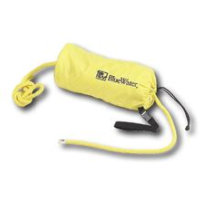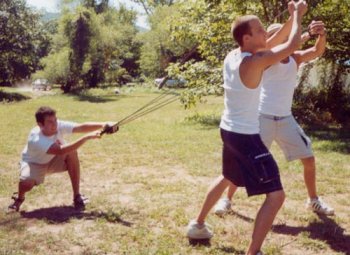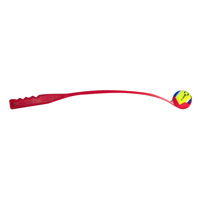
Photo is from Blue Water River Rescue and it copyrighted by them.
*Getting a Line Across*
When someone asks you if you can "get a line across", most people start trying to remember a funny joke or respond they donít speak well in public.
But, if you are a member of a river rescue team, "getting a line across" takes on a whole new meaning. Your teammates and buddies are then asking if you can get a rope across some obstacle, like a raging river or flood wash, rapidly and efficiently. As rescue teams all over the world have discovered, there are dozens and dozens of ways to run or string a rope. This article will present some of those methods, but certainly not all of them. The specific situation and your own creative thinking will likely formulate unique solutions. However, maybe the basic techniques in this article will be the spark you need to come up with a solution more quickly in a pinch.
The techniques mentioned are ones our Swiftwater Rescue Team have devised during a few brainstorming sessions and while in the field when something simply had to be done. Iím not saying these are the best solutions, but again, they are a place to start to get you thinking.
The Problem / When or Why would you need to get a rope across?
In swiftly moving water, where creeks have become raging rivers, there are always reasons to have a rope running across the water. It might be to ferry rescuers from one side of the river to a submerged vehicle. Or, it might be to steady a partially submerged vehicle which is threatening to flip and tumble in the torrent, with people inside. There are times when you need to run a line across a ravine or even up or down a cliff face to help in your ascent or descent.
These are problems which river and flood rescuers face every day. But, even if you arenít a rescuer, having knowledge of these techniques might come in handy when you least expect it.
For the sake of argument, weíll assume that whatever you wish to span is too far to simply toss the rope across. So, weíre probably talking about at least 20 to 30 feet, but most of these techniques were designed for longer distances of 50-100 feet or significantly more.
Leader Lines
There are situations where throwing a heavy, large diameter rope isnít feasible. The weight of a large rope itself will actually work against you and your ability to get any distance on the throw. So, what rescuers often do is use a leader line. A leader line is basically a thin, light-weight line (often heavy fishing line) which is light enough and spools out easily enough so it doesnít impair how far you can throw it. Then, the line must be strong enough to pull a heavier rope across once they are lashed together.
Of course, getting the leader line across is another story. Thatís where many of the ideas below come into play.
Rope Bag Throw
Sometimes all you need is a little extra weight at the end of the normal rescue rope. Most water rescue teams use Rope Bags for this. These are small nylon bags, about the size of a one gallon milk jug. They usually have a plastic or hard foam disk in the bottom where the end of the rope is tied. Sometimes, a few tire weights will be sewn into the bottom of the bag as well to give it a few extra ounces of weight. Then, you simply stuff the rope into the bag, making sure to leave the loose end hanging out, preferably with a good knot to make it easy to hold and stop. To use the throw bag, you pull out a few feet of rope, holding the knot of course, and toss the bag. The remaining rope in the bag, the bag itself and whatever extra weight youíve added actually provides enough weight to get significant distance, with considerable accuracy. The nice thing about a rope bag is the rope rarely, if ever, gets tangled and snagged as it plays out during the throw. The key is not to wad up the rope and stuff it in all at one time, but simply feed it in as if you were fishing an electrical wire down a hole in the wall, a little at a time.

Photo is from Blue Water River Rescue and it copyrighted by them.
We use rope bags mainly for people rescue. If someone, a rescuer or victim, is floating down stream, with a little practice you can accurately throw the rope bag to them and allow them to self-rescue. This technique also works for covering short distances if you want to run a line as well. Since throw bags are a standard part of river rescue equipment, this is often used on the first attempt to run a line.
Baseball Throw
Many people, especially boys, grew up playing baseball. Consequently, hours have been spent "practicing" this throwing technique with exactly the same ball. Our swiftwater team took a baseball and drilled a lag screw into it (a threaded screw on one end and a loop at the other). That way, we have a regulation baseball, with a metal loop sticking out of one side. You simply tie a leader line, like a 100 lb test fishing line, to the loop, then throw the ball. With this technique, make sure you have someone else holding the spool of line on a stick or reel where it can play out quickly with little resistance. We will occasionally pull out 50-100 feet of line and let it lay on the ground so the spool spinning doesnít create additional resistance for the thrower.
Oddly enough, the metal screw and attached line donít really mess up your throw much and donít significantly impact the distance, assuming the fishing line can play out from the spool freely.
And before anyone asksÖ yes, we have been known to keep a baseball glove in the swiftwater van for just such occasions.
But seriously, one of the nice things about the baseball technique is the distance most athletes (or former athletes) can achieve with it. And, there is little or no training required. You simply hand someone a baseball and point to where you want them to throw it.
Bow and Arrow
Okay, who hasnít seen someone in a movie shoot an arrow trailing a rope? Yeah, we had all seen it too. Then we tried it. Then we tried it again, and again, and again. Our studies showed you canít easily send a rope of any size very far that way. The rope simply weighs too much and it severely impacts the distance and accuracy of the shot.
But, like the baseball, we did have some luck using a leader line. However, with an arrow, it is even more important that the leader line come off the spool very quickly and easily. Because most arrows are pretty light weight, even the slightest tug from the trailing line will cause the arrow to deviate or fall short.
Keep in mind there will likely someone on the other side who will "receive" your shot. If you are planning on using an arrow, an accurate shot could seriously injure your buddies on the other side. So, keep everyone well clear of the target area and make sure your shooter is well practiced.
Sling Shot
At first, a small, handheld sling shot sounded like it might work well and be quite portable. However, notice how small the "shot" is for a slingshot. Even the big ammo is not much bigger than a ball bearing. Again the problem becomes an issue of weight. The ammo we tried simply wasnít heavy enough to carry even a leader line very far.
However, then someone went to a college football game. If youíve been to one lately, you might have noticed the cheerleaders using a huge three person slingshot. Officially, I believe the college kids call it a water balloon sling shot launcher. Basically, one person holds each end of a six foot long slingshot. Then, the third person loads the device and takes about three or four steps backward. We saw three girls use this thing to throw Nerf footballs and rolled up t-shirts half way out of the stadium. We had to try one! We found one online at a college frat supply store (yes, they actually have them) for less than $20.

Note: This was the only picture I could find of this device and it came from an internet site some time ago. It is not my picture.
If it is from your site, please let me know and I will be happy to provide a copyright notice. Sorry.
For our purposes, it was absolutely awesome! It was portable, easy to setup and use and required almost no training (especially if you are the anchor guy on the end holding the bungy cords). Aiming with any level of accuracy takes some practice, but this thing can throw a ball with a rope (or leader line) attached at least 50-75 yards without straining at all. We used one of our baseballs with the metal eye screws attached. Absolutely incredible the distances we could get, often over 150 yards!
Needless to say, this thing went directly into the Swiftwater Teamís "Bag of Tricks". And, itís a lot of fun to play with at the end of a hard training session. I personally like what it does to a few water balloons.
Tennis Ball Thrower
Once the team realized that the baseball and eye screw was nearly the perfect size and weight for throwing and trailing a leader line, we started watching for things which threw baseball type objects.
One of our members then appeared at a training session with a dogís tennis ball thrower. I believe the store calls it a "ChuckIt!", but he found it in the dog section of the local PetCo. It is basically a short plastic stick. You put a tennis ball in a scoop on one end, and hold the other end. When you make a throwing motion, the device whips the ball around and you get some good distance. It gives you the same performance increase as a lacrosse stick, which is acceptable in many applications.

Photo Copyright PetCo Inc.
These are great if you are tasked with getting a line across alone or in a small group. They are inexpensive, at about $10, are very durable and are made of plastic, so they float.
Lacrosse Stick
Okay, so that brings up the lacrosse stick. In the southern part of the United States, lacrosse is just becoming popular among the private schools, so not many of us old timers are all that familiar with lacrosse. We do have one guy on the Swiftwater team who can do nearly anything with one, including catch. So, you can probably imagine what job he gets when itís time to run a line, especially since heís one of the rookies on the team.
However, if you have the skills, the lacrosse stick canít be beaten for accuracy, but for us, it works much better in catching the ball and line than it does throwing.
Tying Off the Rope
Once you get the rope across, not just the leader line, it is important to secure the rope so your efforts will not be in vain. The type of knot and proper anchor point will not be covered here since that could fill not only another article, but an entire book.
Get Proper Training
Suffice it to say, you should have the proper training before working around moving water. Just because you have read an article or two on water rescue, does NOT make you trained (or even safe) around moving or swift water. If these types of rescues interest you, please contact your local fire/rescue team for proper training.
Centurion
www.alpharubicon.com
All materials at this site not otherwise credited are Copyright © 1996 - 2005 Trip Williams. All rights reserved. May be reproduced for personal use only. Use of any material contained herein is subject to stated terms or written permission.